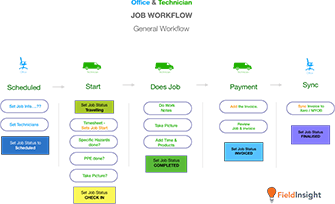HVAC Business Plan Template & Examples (2023 Guide)
Why is it necessary to have a HVAC business plan?
One of the biggest challenges in setting up a business plan is making sure you’ve set reasonable expectations and goals. For any commercial HVAC business, you want to set direction and move towards goals to ensure you are moving the needle for your HVAC business.
The key to sticking to your goals is FOCUS.
To begin your business plan for your HVAC company you can start with simple steps like creating a business canvas to capture ideas. This starts by defining who your target market is and leads in to how you determine your marketing and sales strategies all the way through to how you perceive customer success (how well you are rated/reviewed etc).
A key aspect of success is being able to grow in sophistication without getting buried in the technical operations day to day. You need to be able to look at the different elements of your business, determine the performance against targets so you know if you are on track or heading off a cliff.
For your heating and air conditioning business you want to construct a template for your business so you can track growth, boost productivity and your profit margins consistently month on month or year on year. Running a HVAC business has many challenges and unfortunately not all businesses become successful. In fact, 50% of businesses fail within the first twelve months. As in any industry, you need to be competitive, have high quality of work and superior customer service and these will help your business grow both in reputation and profitability.
Without a defined plan you may find your business is remaining stagnant or even worse, going backwards.
The above is a business planning tool used in Silicon Valley by start-up companies. It allows you to capture all of the key information on a single page. It’s called the Business Model Canvas.
This canvas template gets you to ask the right questions and can be a powerful tool for growth. Focus on customer service, marketing plans, financial profit and loss statements and operations for your business helps you track the right metrics towards profitability. We are going to run through the Business Model Canvas and help you start a new business, a second business or even improve your current business.
Essentially, this process helps you create a North Star for your business, it is highly visible to the whole team, its a clear goal you are all working towards. A North Star is a single metric that gives you the best indicator of success.
To create your business plan you need to do the research…
- Know your audience?
- Have the right information to add to your business plan
- Consider who else is interested in your business plan
- Be precise in what you put in to your plan and just as important what you leave out
Question: What would it mean if your business was profitable and generating enough money to achieve your goals?
- more time with family
- a business that runs itself so you can focus on the next thing
9 Factors to Include in Your HVAC Plan
The Business Model Canvas as a template can give your HVAC business some structure and clarity. This model is typically broken into nine segments that we will dive into.
1. Customer Segments
Who are your customers? Do you know what your customer avatar is? Can you deliver superior customer service for your targeted avatar? You want to document who you are going after and what problem you are solving for them. By knowing who your audience is and their problem you will know how to target and access them through the development of an effective HVAC marketing plan.
You could be targeting residential customers in your local geographic area or commercial businesses doing larger projects, universities, hospitals, restaurants and more. It is vital to have a clear picture of who you are going after and what sort of services are going to be best suited and how to price them. This also helps you determine what products / suppliers / vendors you want to develop relationships with.
Next you need to know the channel or platform to reach these customers (Tip 3). You want to find the place where your customers expect to find you, ready about your services and see your reviews. After acquiring the customer/job the challenge to create a profit (after the cost of acquiring a customer is covered). Once you have this process correct and you are getting leads and making a profit from the work, all you need to do is repeat.
2. Value Propositions
Now you know who your customer is, think about what they want and how to interact with them? This can be as simple as saying you are always on time or always extremely professional or always low cost. Getting a clear proposition for your sales strategy can help your HVAC company gain those potential customers you have just found.
You’ll know you’ve got your value proposition correct when your quotes are coming through and being accepted with a high rate – such as 50% success rate. This comes down to interacting with customers and listening to their wants and needs during the quoting process. It is also inclusive of the goal you have in mind for your HVAC company.
3. Channels
What platforms or channels are your customers using when they are looking for services? Why you may be more successful in certain channels and not others? What channel you chose will determine how you interact with your customers. Doing a bit of research is important in knowing what channels are successful for HVAC businesses and what isn’t as effective. A test, fail and learn attitude is important to ensure you dont put all your eggs in one basket and it gives you options to tap leads when you need to.
When thinking about your business plan, think about different ways you can pull in potential customers. This could be a marketing strategy or HVAC sales techniques like emails, flyers or even word of mouth but it could also be digital platforms like ads on social media or internet channels.
For your HVAC company you might find that a particular channel will be more successful than another might be. When you can determine which platforms work for you, you will be able to fit your team’s business plan into your marketing strategy.
Social Media channels
Starting a HVAC business plan means first bringing in the jobs and potential clients. You may also find with a bit of research that your customers may shift channels over time. COVID19 for example, has been a disruption that has changed where you will normally find your customers. You haven’t lost those clients, they have just moved to different platforms.
3.1 Marketing
Marketing can come into play with channels when you consider options like SEM, SEO, word of mouth and printed media. SEO is Search Engine Optimisation and this means that your results will be ranked based on keywords in search engine results. SEO needs an amazing website that is full of content that is specific to your industry and where customers expect to find you to solve the problems they are having.
SEM or Search Engine Marketing is based on paid advertising on platforms like Facebook, Instagram, LinkedIn or Google. There are options to suit every HVAC business plan and every unique HVAC customer base.
You want your HVAC marketing plan to be a sales strategy that is inclusive to your customer base and adjustable as your business grows and changes.
4. Customer Relations
When you talk about customer relations in your HVAC business plan, you are talking about how you deal with your customers. From the moment they contact you (through whatever medium best suits them phone, online form, facebook messenger etc) to getting a quote to the moment they write the cheque and give you a glowing review about your excellent service! Each of these interactions are important and should be scrutinised regularly or surveyed with customers to find where they can be improved for the customer.
Are you approachable if the customer has questions? Can they contact someone if there is an issue? Step into your customer’s shoes and take a critical look at your own HVAC company to see if your HVAC services match both your market research and your customer’s needs. You wont do well if you are pitching product & services at a Commercial customer but attracting residential customers.
Both before and after you have completed your customer’s work you want to ensure you can keep a good relationship for those repeat jobs and customer reviews. Customer relations can make or break a business based on your professionalism and efficiency. If you have technicians on the site who are rude while servicing the heating or air conditioning unit it will always look bad – check out our Post in Customer Service Tips in 2020 for HVAC.
The same goes for when the customer rings the office to complain and they get an answering machine or a rude receptionist who isn’t interested in helping. The way you handle your customers will contribute to your ability to get more more from them or completely obliterate your ability to attract more customers in the future.
Customer and technician
5. Revenue Streams
Having good HVAC accounting practices in your HVAC company and a healthy profit margin will allow your business to grow. If you have bad revenue streams that are not high yielding you might find your business will stagnant or even move backwards. For growth and expansion to occur in any HVAC business, you need to have set goals that outline the way in which you intend to price your jobs and schedule enough work to be profitable. It may be a challenge to work out and document but with the right set up, you will find your business will boom.
When you think about how to start a HVAC business, it can be easy to get stuck in all these technical details without making sure you are delivering to your customers. If you focus too much on the customer side of things and don’t charge enough in your quotes, you will lose money and wonder why you aren’t profitable. This is not how you start a successful business and it can be a slippery slope on the path to failure if close monitoring and changes are not made.
You need to be thinking smart when planning your revenue and tracking your income sources. A great book to read is Profit First by Mike Michalowicz, it helps get your head right for starting your business.
6. Key Activities
Are you happy with the level of service you are providing to customers? What activities do your team undertake to deliver quality customer service? Do you have a published duty of care, a minimum set of standards for customer engagements. Does the team have a HVAC maintenance checklist in the field to ensure they can delivery quality fast? Do you get good and bad feedback from customers, are you trying to work out where the weakest links are and put in place strategies to remedy. This is a constant battle and an area you need to regularly perform a litmus test on. Bad habits left too long become entrenched and can be difficult to change.
When thinking about your key activities as a HVAC business, you need to understand the services your customers expect you to provide and balance how they can be profitable. In this step you are bringing in your findings and learnings from the previous steps to give you a sound understanding of the activities of your business. Ask yourself, what services do your HVAC team provide? How can you divide these services up into profitable or not profitable items?
Think about your customer’s problem and the steps needed to complete their job. How can you deliver a satisfactory and suitable outcome for the service they’re looking for? They don’t want to over pay and you don’t want to lose money on the job. You need to consider your profit structure for each of your key activities. Once you have mapped out each step you can see where you might need improvement and where you are already doing great.
Finding those money pits are important to rectifying that problem. This may be that you need one technician rather than two to go out to a service call for an air conditioning unit or loading work in a specific area of town to reduce travel between jobs and keeping travel expenses down and being able to fit more jobs in to a single day.

Keeping track
Keep track of your customer database and your processes such as invoicing, purchase orders, quoting and office to get a better look at where your time and money is being spent.
Divide your activities into sections such as:
- Job booking in the office
- Job completion in the field
- What does the technician need to do once on site?
- How does a technician greet a customer?
- What safety documentation do they need to complete?
- Do they have a checklist of jobs to complete of the servicing steps needed?
- What reporting needs to be generated or supplied to the customer?
By breaking your process and key activities down into segments, you can review each area regularly to look for improvements.

Simple Job workflow
7. Key Resources
Regardless of whether you have a business that has been running for a year or one for 100 years – staff management is an unavoidable activity. The pain of not having the right team can be a difficult problem for any HVAC business to overcome. Consider if your hiring process is up to scratch as you may need to take a look at who and how you hire. Are you looking in the right places for your new hires? Do they have the right level of experience? A good rule to stick by is “be slow to hire and quick to fire”. You don’t want to rush into hiring the wrong person and end up in a worse position than if you only waited for the right person. You really need to be impersonal when it comes to hiring and firing. You want to create a criteria for your dream team and make sure that each new hire fits the standard you want to maintain.
Next, is the team provided enough training to keep their skills current? Do you have enough systems in place to look after your team – safety etc? Once you have gotten yourself a killer team for both office and field, your HVAC company will really have the chance to grow and become successful. You need to foster a continuous open communication between the field and office so any minor process issues can be resolved quickly and not impact the flow and pace of your growth. Leverage the mindset of bettering your business’s collective skills.
7.1 Some processes to think about:
What processes have you got in place for dispatching technicians in the field?
Your office is a key part of your business and it needs to be able to communicate with the field with ease. You don’t want a slow system that will reduce productivity because you are waiting on a technician to get some paperwork back to the office. Do you have an efficient system for creating schedules and managing completed activities that need follow-up?
Consider whether you have an efficient inventory management system. You don’t want to waste time chasing part numbers and looking in the back of your vans to try and find them. You need to have the resources on hand to be able to find what you need, when you need it.
Ideally, you want a software that can create automatic links between your business to create a united and productive unit.
HVAC apps
All this will undoubtedly have a lot of trial and error, but with a little practice you will find that your HVAC team has the right resources needed to succeed. If you find that your team is disorganised or lacking in skills, your whole business can suffer. You don’t want to wait until you have started that downwards spiral before you do something to change it.
8. Key Partnerships
Developing key partnerships can be very empowering to your HVAC company. You may have a services skill set and want to build up an installation side of a business and you know someone who’s really good at installation. You can take on the services side and they can take on the installation side. You may want to partner with someone who’s great at Electrical and you do the Plumbing. You might be great for BMS systems and they might be great at commercial construction. In having HVAC partnerships it can be incredibly powerful for all parties.
The downside is they can be a drain on your time and when things get sloppy with one partner this can have a detrimental impact on your business. It is really important when mapping out partnerships that you jointly map out the workflow between the various teams and ensure the handovers are smooth for both the teams and the customer. You will need to document the boundaries and operating procedures prior to starting any partnership.
You should also have the same attitude with starting a new partnership as you should with hiring a new team member. You should be slow and reluctant to enter a partnership but quick to exit one of it turns sour or isn’t working for you.
Partnerships can be a massive accelerator but they are something to be approached with extreme caution and regard for your own business and reputation.
9. Cost Structures
Do you know what your cost structures look like in your HVAC business? Do you have a list of your core costs? Your cost structures ideally should give you a clear financial view; profit and loss statement, balance sheet and a cash flow forecast.
Your profit and loss statement is summary of all your expenses and income and usually calculated on a monthly basis. By having this, it can contribute to seeing those parts of your business that might be using up too much expense and reveal those parts that might need a little more love.
money and paper flying around
You can set up a balance sheet where you have all of your various accounts and buckets of money set up to see where everything is going. Tools such as Xero’s balance sheets can be a real time saver and a good example as to what your projections and cash flow should be looking like.
A cash flow forecast is essential as you don’t want to get too off track and realise suddenly that your HVAC business has run out of available funds. You want to be able to track how your business is going and how profitable you are. You don’t want to wait until the train has run you off the tracks, you want to know that the train is coming a good few weeks before so you can take action.
Having bad cash flow is probably the biggest killer of businesses, starting out a cash flow forecast can dramatically improve the management of your risk.
Key summary
In the HVAC field industry there are numerous challenges that can make running a successful business even harder. But you don’t have to lose hope. The top things you can include in your HVAC plan to help you reach success are:
- Know your customers
- Value propositions with a clear strategy
- Find the right channels to market your business
- Build long lasting relationships with your customers
- Balance your revenue streams
- Map out your business strategies
- Manage your team efficiently
- Develop partnerships with key companies
- Create a cost structure
With these steps you can give your business the best chance to succeed in a competitive market.
One of the best ways you can effectively plan your business is through using your own experience. The most successful businesses always have had their own personal experience to help them guide the do’s and don’ts of the industry. If you don’t have any of your own experience in being a technician, running job sites, or performing maintenance, refer to someone who has. Gaining perspective is always valuable and can help you better understand the needs of your industry.
Why You Should Consider End-To-End Job Management Software When Building Your HVAC Business Plan
When thinking of starting a HVAC business, there is a lot that you need to consider especially when you look at the large rate of failure for many businesses.
Field service management software like FieldInsight can help incorporate all the moving parts of your business into one place. You will have less stress on your shoulders when you have your business running as a unit with your office and field connected.
Mapping out your business canvas can be less of a headache when you have automated software like FieldInsight. Imagine what your business would be able to achieve with an end-to-end job management software like FieldInsight.
What You Should Do Now
- Book a Demo. You’ll be in touch with an automation expert who has worked in this space for over 5 years, and knows the optimal workflow to address your needs.
- If you’d like access to free articles about managing HVAC workflows, go to our blog.
- If you know someone who’d enjoy reading this page, share it with them via email, Linkedin, Twitter, or Facebook.






